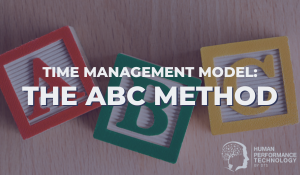Time Management Model: The Eisenhower Matrix
The Eisenhower Matrix is a time management model that helps individuals prioritise their tasks based on their urgency and importance. The model was named after former US President Dwight D. Eisenhower, who was known for his productivity and time management skills.
By using the Eisenhower Matrix, individuals can prioritise their tasks based on their urgency and importance and focus on completing high-priority tasks first. This can help improve productivity, reduce stress, and achieve long-term goals more effectively.
To apply the Eisenhower Matrix, you can follow these steps:
- Make a List of all the Tasks you Need to Complete - Write down all the tasks you have to do, from the most urgent to the least.
- Categorise each Task - Decide which tasks are important and which are urgent. Remember, important tasks are those that contribute to your long-term goals, while urgent tasks require immediate attention.
- Place each Task in the Appropriate Quadrant - Using the matrix, place each task in the appropriate quadrant based on its urgency and importance. This will give you a clear picture of which tasks you should focus on first.
- Prioritise your Tasks - Once you have placed all your tasks in the matrix, focus on the tasks in the top-left quadrant (important and urgent). These are the tasks that require your immediate attention and should be your top priority. Then, move on to the other quadrants based on their importance and urgency.
- Delegate or Eliminate Low-Priority Tasks - Look at the tasks in the bottom-right quadrant (not important and not urgent) and consider whether they can be delegated to someone else or eliminated altogether. This will free up time and energy to focus on the tasks that are most important.
- Review and Adjust - Periodically review your tasks and adjust your priorities as needed. This will help you stay on track and ensure that you are focusing on the tasks that matter most.
By following these steps, you can use the Eisenhower Matrix to manage your time more effectively and focus your energy on the tasks that will have the greatest impact on your goals and priorities.
When is the Eisenhower Matrix most useful?
In our post “10 Super Useful Time Management Models”, we introduced the idea that time management models can usually be organised into three categories; Planning, Prioritising and Executing. We would consider the Eisenhower Matrix, a Prioritising model.
The Eisenhower Matrix is most useful when you are facing a large number of tasks and struggling to prioritise them effectively. It is especially helpful for people who find themselves spending a lot of time on urgent tasks that may not be important at the expense of tasks that are important but not as time-sensitive.
It can help you identify which tasks are most important and require your immediate attention and which tasks can be delegated, postponed, or even eliminated. By categorising tasks according to their urgency and importance, you can focus your time and energy on the tasks that will have the greatest impact on your goals and objectives.
The Eisenhower Matrix is also useful for people who tend to get overwhelmed or bogged down by a long to-do list. By breaking tasks down into smaller, more manageable chunks, you can avoid feeling paralysed by the sheer volume of work you need to do. This can help you stay focused and productive, even when you are dealing with a lot of competing demands on your time.
What are the common challenges when people use the Eisenhower Matrix?
Some common challenges people face when using the Eisenhower Matrix include:
- Difficulty Categorising Tasks - People may struggle to accurately categorise tasks as urgent or important, leading to confusion about which tasks to prioritise.
- Procrastination - Even after tasks have been categorised, people may still procrastinate on tasks that are important but not urgent, leading to a buildup of tasks that become more urgent and stressful over time.
- Overloading - People may try to fit too many tasks into the “important and urgent” category, which can lead to feeling overwhelmed and stressed.
- Lack of Flexibility - People may feel constrained by the rigid structure of the matrix and struggle to adjust it to fit their specific needs.
- Failure to Reassess - People may fail to regularly reassess their tasks and update the matrix, leading to outdated or irrelevant information that no longer reflects their current priorities.
- Inability to Delegate - Some people may struggle to delegate tasks to others, leading to an unrealistic workload and feeling overburdened.

Trevor O'Sullivan
General Manager. Since the early 2000s, Trevor has worked with thousands of Talent Management professionals to develop and apply assessment-based talent management solutions for selecting, developing and managing people. Trevor is an active member of the TTI Success Insights (TTISI) Global Advisory Council, contributes to TTISI product development and is a regular presenter at TTISI-R3. He is honoured to have received multiple Blue Diamond Awards and, more recently, the Bill Brooks Impact Award recognising his contributions to the TTISI global network.



We Would Like to Hear From You (0 Comments)